Radiation
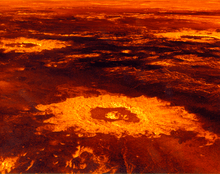
“In physics, radiation is a process in which energetic particles or energetic waves travel through a medium or space.”[1]
At right is an image of an impact crater on the surface of Venus. It is an example of meteor radiation damage.
Rays
Def. an action or process of throwing or sending out a traveling ray in a line, beam, or stream of small cross section is called radiation.
The term radiation is often used to refer to the ray itself.
Def. “[t]he shooting forth of anything from a point or surface, like the diverging rays of light; as, the radiation of heat”[1] is called radiation.
Rays may have a temporal, spectral, or spatial distribution.
They may also be dependent on other variables as yet unknown.
"Beta particles are high-energy, high-speed electrons or positrons emitted by certain types of radioactive nuclei such as potassium-40. The beta particles emitted are a form of ionizing radiation also known as beta rays. The production of beta particles is termed beta decay. They are designated by the Greek letter beta (β)."[2] Bold added.
"A delta ray is characterized by very fast electrons produced in quantity by alpha particles or other fast energetic charged particles knocking orbiting electrons out of atoms. Collectively, these electrons are defined as delta radiation when they have sufficient energy to ionize further atoms through subsequent interactions on their own."[3]
"Epsilon radiation is tertiary radiation caused by secondary radiation (e.g., delta radiation). Epsilon rays are a form of particle radiation and are composed of electrons. The term is very rarely used today."[4] Bold added.
Radiation theory
Def. a theory of the science of the biological, chemical, physical, and logical laws (or principles) with respect to any radiation is called a theory of radiation.
Types of radiation
Particle radiation consists of a stream of charged or neutral particles, from the size of subatomic elementary particles upwards of rocky and gaseous objects to even larger more loosely bound entities.
Meteors
Particle radiation upwards in size above that of atomic nuclei may be lumped together as meteor radiation.
Showers
.jpg)
"Meteors may occur in showers, which arise when the Earth passes through a trail of debris left by a comet, or as "random" or "sporadic" meteors, not associated with a specific single cause. A number of specific meteors have been observed, largely by members of the public and largely by accident".[5]
Lithometeors
Def. "[a] suspension of dry dust ... in the atmosphere"[6] is called a lithometeor.
Def. "[t]he solid material thrown into the air by a volcanic eruption that settles on the surrounding areas"[7] is called tephra.
Micrometeors
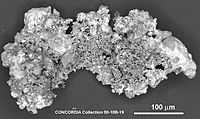
"A micrometeoroid is a tiny meteoroid; a small particle of rock in space, usually weighing less than a gram. A micrometeorite is such a particle that survives passage through the Earth's atmosphere and reaches the Earth's surface."[8]
"Micrometeoroids are extremely common in space. [These tiny] particles are a major contributor to space weathering processes. When they hit the surface of the Moon, or any airless body (Mercury, the asteroids, etc.), the resulting melting and vaporization causes darkening and other optical changes in the regolith."[8]
"Micrometeoroids have less stable orbits than meteoroids, due to their greater surface area to mass ratio."[8]
"Micrometeoroids pose a significant threat to space exploration.[9] Their velocities relative to a spacecraft in orbit average 10 kilometers per second (22,500 mph),[9] and resistance to micrometeoroid impact is a significant design challenge for spacecraft and space suit designers (See Thermal Micrometeoroid Garment). While the tiny sizes of most micrometeoroids limits the damage incurred, the high velocity impacts will constantly degrade the outer casing of spacecraft in a manner analogous to sandblasting. Long term exposure can threaten the functionality of spacecraft systems."[8]
Hydrometeors
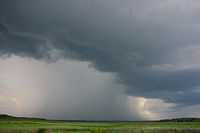
Def. "precipitation products of the condensation of atmospheric water vapour"[10] are called hydrometeors.
Def. "[a]ny or all of the forms of water particles, whether liquid or solid, that fall from the atmosphere"[11] are called precipitation.
Cryometeors
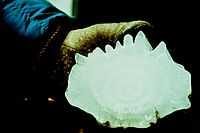
"A megacryometeor is a very large chunk of ice ... sometimes called huge hailstones, but do not need to form in thunderstorms."[12]
Clouds

Def. "[a] visible mass of
- water droplets suspended in the air ...
- dust,
- steam ...
- smoke ...
- a group or swarm"[13] is called a cloud.
"Clouds have been observed on other planets and moons within the Solar System, but, due to their different temperature characteristics, they are composed of other substances such as methane, ammonia, and sulfuric acid."[14]
Aerometeors

Def. a discrete unit of air, wind, or mist traveling or falling through or partially through an atmosphere is called an aerometeor.
Def. "any of the high-speed, high-altitude air currents that circle the Earth in a westerly direction"[15] is called a jet stream.
Plasmas

A coronal cloud is a cloud, or cloud-like, natural astronomical entity, composed of plasma and usually associated with a star or other astronomical object where the temperature is such that X-rays are emitted. While small coronal clouds are above the photosphere of many different visual spectral type stars, others occupy parts of the interstellar medium (ISM), extending sometimes millions of kilometers into space, or thousands of light-years, depending on the size of the associated object such as a galaxy.
At left is a radiated object and its associated phenomena.
"Ultra-violet studies of Mira by NASA's Galaxy Evolution Explorer (Galex) space telescope have revealed that it sheds a trail of material from the outer envelope, leaving a tail 13 light-years in length, formed over tens of thousands of years.[16][17] It is thought that a hot bow-wave of compressed plasma/gas is the cause of the tail; the bow-wave is a result of the interaction of the stellar wind from Mira A with gas in interstellar space, through which Mira is moving at an extremely high speed of 130 kilometres/second (291,000 miles per hour).[18][19] The tail consists of material stripped from the head of the bow-wave, which is also visible in ultra-violet observations. Mira's bow-shock will eventually evolve into a planetary nebula, the form of which will be considerably affected by the motion through the interstellar medium (ISM).[20]"[21]
Ionizing
While large objects may induce the gain or loss of charge from another object, ionizing radiation is usually thought of as on the order of or smaller than an atom.
“Different types of ionizing radiation behave in different ways, so different shielding techniques are used.
- Particle radiation consists of a stream of charged or neutral particles, both charged ions and subatomic elementary particles. This includes solar wind, cosmic radiation, and neutron flux in nuclear reactors.
- Alpha particles (helium nuclei) are the least penetrating. Even very energetic alpha particles can be stopped by a single sheet of paper.
- Beta particles (electrons) are more penetrating, but still can be absorbed by a few millimeters of aluminum. However, in cases where high energy beta particles are emitted shielding must be accomplished with low density materials, e.g. plastic, wood, water or acrylic glass (Plexiglas, Lucite). This is to reduce generation of Bremsstrahlung X-rays. In the case of beta+ radiation (positrons), the gamma radiation from the electron-positron annihilation reaction poses additional concern.
- Neutron radiation is not as readily absorbed as charged particle radiation, which makes this type highly penetrating. Neutrons are absorbed by nuclei of atoms in a nuclear reaction. This most-often creates a secondary radiation hazard, as the absorbing nuclei transmute to the next-heavier isotope, many of which are unstable.
- Cosmic radiation is not a common concern, as the Earth's atmosphere absorbs it and the magnetosphere acts as a shield, but it poses a problem for satellites and astronauts and frequent fliers are also at a slight risk. Cosmic radiation is extremely high energy, and is very penetrating.
- Electromagnetic radiation consists of emissions of electromagnetic waves, the properties of which depend on the wavelength.
- X-ray and gamma radiation are best absorbed by atoms with heavy nuclei; the heavier the nucleus, the better the absorption. In some special applications, depleted uranium is used, but lead is much more common; several centimeters are often required. Barium sulfate is used in some applications too. However, when cost is important, almost any material can be used, but it must be far thicker. Most nuclear reactors use thick concrete shields to create a bioshield with a thin water cooled layer of lead on the inside to protect the porous concrete from the coolant inside. The concrete is also made with heavy aggregates, such as Baryte, to aid in the shielding properties of the concrete.
- Ultraviolet (UV) radiation is ionizing but it is not penetrating, so it can be shielded by thin opaque layers such as sunscreen, clothing, and protective eyewear. Protection from UV is simpler than for the other forms of radiation above, so it is often considered separately."[22]
"In some cases, improper shielding can actually make the situation worse, when the radiation interacts with the shielding material and creates [bremsstrahlung] secondary radiation that absorbs in the organisms more readily.”[22]
Superluminals
"The existence of superluminal energy transfer has not been established so far, and one may ask why. There is the possibility that superluminal quanta just do not exist, the vacuum speed of light being the definitive upper bound. There is another explanation, the interaction of superluminal radiation with matter is very small, the quotient of tachyonic and electric fine-structure constants being q2/e2 ≈ 1.4 x 10-11 [5], and therefore superluminal quanta are hard to detect."[23]
Cherenkovs
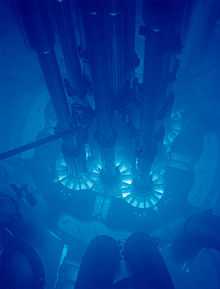
At right is an example of Cherenkov radiation. "Cherenkov radiation (also spelled Čerenkov) is electromagnetic radiation emitted when a charged particle (such as an electron) passes through a dielectric medium at a speed greater than the phase velocity of light in that medium."[24] Cherenkov radiation is an example of medium specific superluminals.
Entities
“The electron is a subatomic particle with a negative charge, equal to -1.60217646x10-19 C. Current, or the rate of flow of charge, is defined such that one coulomb, so 1/-1.60217646x10-19, or 6.24150974x1018 electrons flowing past a point per second give a current of one ampere. The charge on an electron is often given as -e. note that charge is always considered positive, so the charge of an electron is always negative."[25]
Sources
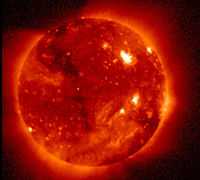
Def. the point of origin of a ray, beam, or stream of small cross section traveling in a line is called a radiation source.
The image at right is the first X-ray light image of the Sun by the satellite GOES-15 Solar X-ray Imager (SXI) on June 2, 2010. The surface of the Sun, beneath the coronal cloud layer is dark. The coronal cloud is the actual source of the X-rays.
"TeV muons from γ ray primaries ... are rare because they are only produced by higher energy γ rays whose flux is suppressed by the decreasing flux at the source and by absorption on interstellar light."[26]
"Muon decay produces three particles, an electron plus two neutrinos of different types."[27]
"Electrons moving along a Birkeland current may be accelerated by a plasma double layer. If the resulting electrons approach relativistic velocities (i.e. if they approach the speed of light) they may subsequently produce a Bennett pinch, which in a magnetic field causes the electrons to spiral and emit synchrotron radiation that may include radio, optical (i.e. visible light), x-rays, and gamma rays."[28]
""Dark" lightning is a type of electrical discharge within a thunderstorm that produces what are called terrestrial gamma-ray flashes."[29]
"The fields accelerate electrons to almost the speed of light. Then, the electrons smash into air molecules and produce gamma-rays. The gamma-rays then produce electrons and their antimatter equivalents (positrons). These particles next crash into air molecules, and produce even more gamma-rays."[29]
Objects

Electrons "provide remote-sensing observations of distant targets in the heliosphere - the Sun, the Moon, Jupiter, and various heliospheric structures."[30]
The image at right is a painting by artist Giorgio Vasari (1511–1574). The main focus is on Cronus (Saturn) castrating Uranus (the Greek sky god). As both Uranus and Cronus are represented by men, this suggests that they were similar in nature. "[T]he ancients’ religions and mythology speak for their knowledge of Uranus; the dynasty of gods had Uranus followed by Saturn, and the latter by Jupiter. ... It is quite possible that the planet Uranus is the very planet known by this name to the ancients. The age of Uranus preceded the age of Saturn; it came to an end with the “removal” of Uranus by Saturn. Saturn is said to have emasculated his father Uranus."[31]
Continua

Def. a "continuous series or whole, no part of which is noticeably different from its adjacent parts, although the ends or extremes of it are very different from each other"[32] is called a continuum.
Above is the electromagnetic spectrum. When each wavelength has the same intensity and background, the entire spectrum is a continuum. More generally, "the electromagnetic spectrum, is often termed as either continuous (with energy at all wavelengths) or discrete (energy at only certain wavelengths)."[33]
Emissions

Def. "[t]he act of sending or throwing out; the act of sending forth or putting into circulation"[34] is called emission.
"In physics, emission is the process by which a higher energy quantum mechanical state of a particle becomes converted to a lower one through the emission of a photon, resulting in the production of light. The frequency of light emitted is a function of the energy of the transition. Since energy must be conserved, the energy difference between the two states equals the energy carried off by the photon. The energy states of the transitions can lead to emissions over a very large range of frequencies. For example, visible light is emitted by the coupling of electronic states in atoms and molecules (then the phenomenon is called fluorescence or phosphorescence). On the other hand, nuclear shell transitions can emit high energy gamma rays, while nuclear spin transitions emit low energy radio waves."[35]
Absorptions
Def. the act or process of including so that a separate existence is no longer is called absorption.[36][37]
"There are a number of ways to quantify how quickly and effectively radiation is absorbed".[38]
"The attenuation coefficient is a quantity that characterizes how easily a material or medium can be penetrated by a beam of light, sound, particles, or other energy or matter."[39]
"The range of a heavy charged particle is approximately proportional to the mass of the particle and the inverse of the density of the medium, and is a function of the initial velocity of the particle."[40]
Def. " the average energy loss of the particle per unit path length"[41] is called stopping power.
Bands
"Spectral bands are part of optical spectra of polyatomic systems, including condensed materials, large molecules, etc. Each line corresponds to one level in the atom splits in the molecules. When the number of atoms is large, one gets a continuum of energy levels, the so called "spectral bands". They are often labeled in the same way as the monatomic lines."[42]
"Band spectra is the name given to a group of lines that are closely spaced and arranged in a regular sequence that appears to be a band. It is a colored band, separated by dark spaces on the two sides and arranged in a regular sequence. In one band, there are various sharp and wider color lines, that are closer on one side and wider on other. The intensity in each band falls off from definite limits and indistinct on the other side. In complete band spectra, there is a number lines in a band."[42]
"The band spectrum is the combination of many different spectral lines, resulting from rotational, vibrational and electronic transition."[42]
Backgrounds
"Background radiation is the ubiquitous ionizing radiation that the general population is exposed to, including natural and artificial sources. Both natural and artificial background radiation varies by location."[43]
"The worldwide average natural dose to humans is about 2.4 millisievert (mSv) per year.[44]"[43]
"The biggest source of natural background radiation is airborne radon, a radioactive gas that emanates from the ground. Radon and its isotopes, parent radionuclides, and decay products all contribute to an average inhaled dose of 1.26 mSv/a. Radon is unevenly distributed and variable with weather, such that much higher doses apply to many areas of the world, where it represents a significant health hazard. Concentrations over 500 times higher than the world average have been found inside buildings in Scandinavia, the United States, Iran, and the Czech Republic.[45]"[43]
"Terrestrial radiation ... [usually] only includes sources that remain external to the body. The major radionuclides of concern are potassium, uranium and thorium and their decay products, some of which, like radium and radon are intensely radioactive but occur in low concentrations."[43]
"An average human contains about 30 milligrams of potassium-40 (40K) and about 10 nanograms (10−8 g) of carbon-14 (14C), which has a decay half-life of 5,730 years. Excluding internal contamination by external radioactive material, the largest component of internal radiation exposure from biologically functional components of the human body is from potassium-40. The decay of about 4,000 nuclei of 40K per second[46] makes potassium the largest source of radiation in terms of number of decaying atoms. The energy of beta particles produced by 40K is also about 10 times more powerful than the beta particles from 14C decay. 14C is present in the human body at a level of 3700 Bq with a biological half-life of 40 days.[47] There are about 1,200 beta particles per second produced by the decay of 14C. However, a 14C atom is in the genetic information of about half the cells, while potassium is not a component of DNA. The decay of a 14C atom inside DNA in one person happens about 50 times per second, changing a carbon atom to one of nitrogen.[48] The global average internal dose from radionuclides other than radon and its decay products is 0.29 mSv/a, of which 0.17 mSv/a comes from 40K, 0.12 mSv/a comes from the uranium and thorium series, and 12 μSv/a comes from 14C.[44]"[43]
"[B]ackground radiation may simply be any radiation that is pervasive, whether ionizing or not. A particular example of this is the cosmic microwave background radiation, a nearly uniform glow that fills the sky in the microwave part of the spectrum; stars, galaxies and other objects of interest in radio astronomy stand out against this background."[43]
"In a laboratory, background radiation refers to the measured value from any sources that affect an instrument when a radiation source sample is not being measured. This background rate, which must be established as a stable value by multiple measurements, usually before and after sample measurement, is subtracted from the rate measured when the sample is being measured."[43]
Damages
Def. "susceptibility of a material to physical or chemical changes induced by radiation"[49] is called radiation sensitivity.
"The radiation effect depends on the type of the irradiating particles, their energy and the number of incident particles per unit volume."[49]
Def. "[h]armful changes in the properties of materials caused by interactions with ionizing radiation"[50] is called radiation damage.
"Radiation damage is a term [usually] associated with ionizing radiation."[51]
"Radiation may affect materials and devices in deleterious ways:
- By causing the materials to become radioactive (mainly by neutron activation, or in [the] presence of high-energy gamma radiation by photodisintegration).
- By nuclear transmutation of the elements within the material including, for example, the production of Hydrogen and Helium which can in turn alter the mechanical properties of the materials and cause swelling and embrittlement.
- By radiolysis (breaking chemical bonds) within the material, which can weaken it, cause it to swell, polymerize, promote corrosion, cause belittlements, promote cracking or otherwise change its desirable mechanical, optical, or electronic properties.
- By formation of reactive compounds, affecting other materials (e.g. ozone cracking by ozone formed by ionization of air).
- By ionization, causing electrical breakdown, particularly in semiconductors employed in electronic equipment, with subsequent currents introducing operation errors or even permanently damaging the devices."[51]
"Exposure to radiation causes chemical changes in gases."[51]
"High-intensity ionizing radiation in air can produce a visible ionized air glow of telltale bluish-purplish color."[51]
"Like gases, liquids lack fixed internal structure; the effects of radiation is therefore mainly limited to radiolysis, altering the chemical composition of the liquids. As with gases, one of the primary mechanisms is formation of free radicals."[51]
"All liquids are subject to radiation damage, with few exotic exceptions; e.g. molten sodium, where there are no chemical bonds to be disrupted, and liquid hydrogen fluoride, which produces gaseous hydrogen and fluorine, which spontaneously react back to hydrogen fluoride."[51]
Astronomy
When any effort to acquire a system of laws or knowledge focusing on an astr, aster, or astro, that is, any natural body in the sky especially at night,[52] succeeds in discovering or exploring radiation even in its smallest measurement, radiation astronomy is the name of the effort and the result. Once an entity, source, or object has been detected as having radiation, it may be necessary to determine what the mechanism is. Usually this information provides understanding of the same entity, source, or object. The formation of radiation on Earth and its initial detection by hominins may be associated primarily with the available senses.
Sun
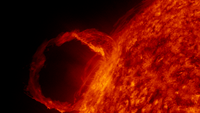
"Energetic photons, ions and electrons from the solar wind, together with galactic and extragalactic cosmic rays, constantly bombard surfaces of planets, planetary satellites, dust particles, comets and asteroids."[53]
Coronal clouds
"Coronal clouds, type IIIg, form in space above a spot area and rain streamers upon it."[54]
A variety of subatomic particle and γ-ray reactions have been observed during solar flares indicating fusion reactions occurring at or above the photosphere. "There are typically 375 gamma-ray flares per solar cycle ... each releasing on average about 1031 erg of kinetic energy in accelerated ions of energy ≥ 1 MeV per nucleon [27]."[55]
"The solar-flare gamma-ray line emission testifies that fresh nuclei are synthesized in abundance in energetic solar events."[55]
"[T]he gamma-ray lines at 478 and 429 keV [are] emitted in the reactions 4He(α,p)7Li and 4He(α,n)7Be, respectively".[55]
Mercury
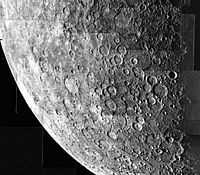
The mosaic image of the rocky-object Mercury at right shows what appears to be meteor damage over a large portion of the surface.
"The mosaic consists of 18 images taken at 42 s intervals during a 13 minute period when the spacecraft was 200,000 km (about 6 hours prior to closest approach) from the planet."[56]
"Mercury's surface is heavily cratered and similar in appearance to Earth's Moon ... Craters on Mercury range in diameter from small bowl-shaped cavities to multi-ringed impact basins hundreds of kilometers across. They appear in all states of degradation, from relatively fresh rayed craters to highly degraded crater remnants. Mercurian craters differ subtly from lunar craters in that the area blanketed by their ejecta is much smaller, a consequence of Mercury's stronger surface gravity.[57]"[58]
Venus
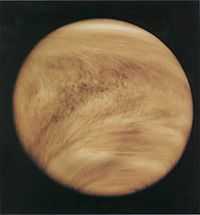
"In 1967, Venera-4 found the Venusian magnetic field is much weaker than that of Earth. This magnetic field is induced by an interaction between the ionosphere and the solar wind,[59][60] ... Venus's small induced magnetosphere provides negligible protection to the atmosphere against cosmic radiation. This radiation may result in cloud-to-cloud lightning discharges.[61]"[62]
"Strong 300 km/h winds at the cloud tops circle the planet about every four to five earth days.[63] Venusian winds move at up to 60 times the speed of the planet's rotation, while Earth's fastest winds are only 10% to 20% rotation speed.[64]"[62]
"While there is little or no water on Venus, there is a phenomenon which is quite similar to snow. The Magellan probe imaged a highly reflective substance at the tops of Venus's highest mountain peaks which bore a strong resemblance to terrestrial snow. This substance arguably formed from a similar process to snow, albeit at a far higher temperature. Too volatile to condense on the surface, it rose in gas form to cooler higher elevations, where it then fell as precipitation. The identity of this substance is not known with certainty, but speculation has ranged from elemental tellurium to lead sulfide (galena).[65]"[66]
Earth

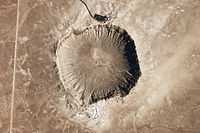

In the image at left is an aerial view of the Barringer Meteor Crater about 69 km east of Flagstaff, Arizona USA. Although similar to the aerial view of the Soudan crater, the Barringer Meteor Crater appears angular at the farthest ends rather than round.
"Meteor Crater is a meteorite impact crater approximately 43 miles (69 km) east of Flagstaff, near Winslow in the northern Arizona desert of the United States. Because the US Department of the Interior Division of Names commonly recognizes names of natural features derived from the nearest post office, the feature acquired the name of "Meteor Crater" from the nearby post office named Meteor.[67] The site was formerly known as the Canyon Diablo Crater, and fragments of the meteorite are officially called the Canyon Diablo Meteorite. Scientists refer to the crater as Barringer Crater in honor of Daniel Barringer, who was first to suggest that it was produced by meteorite impact.[68]"[69]
From space the crater appears almost like a square. The image at right has a resolution of 2 meters per pixel, and illumination is from the right. Layers of exposed limestone and sandstone are visible just beneath the crater rim, as are large stone blocks excavated by the impact.
"The Holsinger meteorite is the largest discovered fragment of the meteorite that created Meteor Crater and it is exhibited in the crater visitor center."[69] "The Canyon Diablo meteorite comprises many fragments of the asteroid that impacted at Barringer Crater (Meteor Crater), Arizona, USA. Meteorites have been found around the crater rim, and are named for nearby Canyon Diablo, which lies about three to four miles west of the crater."[70] "There are fragments in the collections of museums around the world including the Field Museum of Natural History in Chicago. The biggest fragment ever found is the Holsinger Meteorite, weighing 639 kg, now on display in the Meteor Crater Visitor Center on the rim of the crater."[70]
Moon
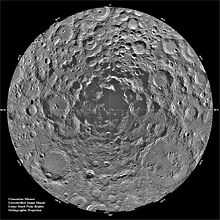
Meteorites have been found on the Moon[71][72]
"Lunar origin [of lunar meteors] is established by comparing the mineralogy, the chemical composition, and the isotopic composition between meteorites and samples from the Moon collected by Apollo missions."[73]
"Cosmic ray exposure history established with noble gas measurements have shown that all lunar meteorites were ejected from the Moon in the past 20 million years. Most left the Moon in the past 100,000 years."[73]
In the image at left, twenty degrees of latitude of the Moon's disk is completely covered in the overlapping circles of craters. The illumination angles are from all directions, keeping almost all the crater floors in sunlight, but a set of merged crater floors right at the south pole are completely shadowed.
Mars
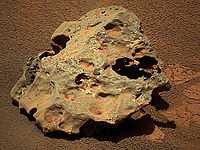
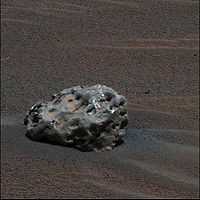
Martian meteors "are thought to be from Mars because they have elemental and isotopic compositions that are similar to rocks and atmosphere gases analyzed by spacecraft on Mars.[74]"[75]
The image at right is of the Mackinac Island meteorite, discovered on Mars by the NASA Opportunity rover on October 13, 2009.[76]
At top left is the first meteorite of any type ever identified on another planet. The pitted, basketball-size object is mostly made of iron and nickel. Readings from spectrometers on the rover determined that composition. Opportunity used its panoramic camera to take the images used in this approximately true-color composite on the rover's 339th martian day, or sol (Jan. 6, 2005). This composite combines images taken through the panoramic camera's 600-nanometer (red), 530-nanometer (green), and 480-nanometer (blue) filters.
Comparison of the two meteorites shown here suggests that the left one is a much more recent fall.
Asteroids
Notation let the symbol EC denote Earth-crossing asteroids.
Notation: let the symbol MB denote the main belt of asteroids.
"From the dominant group, the asteroids evolve to intersect the Earth's orbit on a median time scale of about 60 Myr."[77]
"The MB group is the most numerous group of MCs. ... 50 % of the MB Mars-crossers [MCs] become ECs within 59.9 Myr and [this] contribution ... dominates the production of ECs"[77].
Vesta
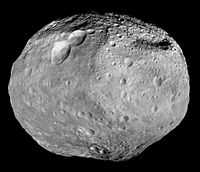
In the full image of Vesta at right, the rocky-object appears to have suffered from meteor damage.
"Vesta, minor-planet designation 4 Vesta, is one of the largest asteroids in the Solar System ... It lost some 1% of its mass less than a billion years ago in a collision that left an enormous crater occupying much of its southern hemisphere. Debris from this event has fallen to Earth as howardite–eucrite–diogenite (HED) meteorites, a rich source of information about the asteroid.[78][79]"[80]
Saturn
"[E]rosion from particles making up the icy rings of Saturn are forming rain water that falls on certain parts of the planet. ... tiny ice particles that compose the planet's distinctive rings are sometimes eroded away and then deposited in the planet's upper atmosphere. The droplets then create a kind of rain on the planet. ... charged water molecules rain down only on certain parts of the planet, which show up darker in infrared images. ... The magnetic connection creates a pathway for small ice particles in the rings to slough off into the planet's atmosphere, causing the "ring rain.""[81]
"The most surprising element to us was that these dark regions on the planet are found to be linked — via magnetic field lines — to the solid portions of water-ice within Saturn's ring-plane"[82].
"Saturn is the first planet to show significant interaction between its atmosphere and ring system ... The main effect of ring rain is that it acts to 'quench' the ionosphere of Saturn. In other words, this rain severely reduces the electron densities in regions in which it falls."[83]
"It turns out that a major driver of Saturn's ionospheric environment and climate across vast reaches of the planet are ring particles located some 36,000 miles [60,000 kilometers] overhead ... The ring particles affect both what species of particles are in this part of the atmosphere and where it is warm or cool."[84]
"Where Jupiter is glowing evenly across its equatorial regions, Saturn has dark bands where the water is falling in, darkening the ionosphere".[85]
Titan

"As spring continues to unfold at Saturn, April showers on the planet's largest moon, Titan, have brought methane rain to its equatorial deserts ... Extensive rain from large cloud systems ... has apparently darkened the surface of the moon."[86]
“It's amazing to be watching such familiar activity as rainstorms and seasonal changes in weather patterns on a distant, icy satellite".[87]
"The Saturn system experienced equinox, when the sun lies directly over a planet's equator and seasons change, in August 2009. (A full Saturn “year” is almost 30 Earth years.)"[86]
"Clouds on Titan are formed of methane as part of an Earth-like cycle that uses methane instead of water. On Titan, methane fills lakes on the surface, saturates clouds in the atmosphere, and falls as rain. Though there is evidence that liquids have flowed on the surface at Titan's equator in the past, liquid hydrocarbons, such as methane and ethane, had only been observed on the surface in lakes at polar latitudes. The vast expanses of dunes that dominate Titan's equatorial regions require a predominantly arid climate."[86]
"An arrow-shaped storm appeared in the equatorial regions on Sept. 27, 2010 -- the equivalent of early April in Titan's “year” -- and a broad band of clouds appeared the next month. ... A 193,000-square-mile (500,000-square-kilometer) region along the southern boundary of Titan’s Belet dune field, as well as smaller areas nearby, had become darker. ... this change in brightness is most likely the result of surface wetting by methane rain."[86]
“These outbreaks may be the Titan equivalent of what creates Earth's tropical rainforest climates, even though the delayed reaction to the change of seasons and the apparently sudden shift is more reminiscent of Earth's behavior over the tropical oceans than over tropical land areas”.[88]
At right is an image that shows clouds over the equatorial region of Titan.
"Methane clouds in the troposphere, the lowest part of the atmosphere, appear white here and are mostly near Titan's equator. The darkest areas are surface features that have a low albedo, meaning they do not reflect much light. Cassini observations of clouds like these provide evidence of a seasonal shift of Titan's weather systems to low latitudes following the August 2009 equinox in the Saturnian system. (During equinox, the sun lies directly over the equator. See PIA11667 to learn how the sun's illumination of the Saturnian system changed during the equinox transition to spring in the northern hemispheres and to fall in the southern hemispheres of the planet and its moons.)"[89]
"In 2004, during Titan's late southern summer, extensive cloud systems were common in Titan's south polar region (see PIA06110, PIA06124 and PIA06241). Since 2005, southern polar systems have been observed infrequently, and one year after the equinox, extensive near-equatorial clouds have been seen. This image was taken on Oct. 18, 2010, a little more than one Earth year after the Saturnian equinox, which happens once in roughly 15 Earth years."[89]
"The cloud patterns observed from late southern summer to early southern fall on Titan suggest that Titan's global atmospheric circulation is influenced by both the atmosphere and the surface. The temperature of the surface responds more rapidly to changes in illumination than does the thick atmosphere. Outbreaks such as the clouds seen here may be the Titan equivalent of what creates the Earth's tropical rainforest climates, even though the delayed reaction to the change of seasons and the apparently sudden shift is more reminiscent of the behavior over Earth's tropical oceans than over tropical land areas."[89]
"A few clouds can be seen in Titan's southern latitudes here. See PIA12813 for a movie of clouds moving through the middle southern latitudes of Titan. Some clouds are also visible in the high northern latitudes here. See PIA12811 and PIA12812 for movies showing clouds near the moon's north pole. This view looks toward the Saturn-facing side of Titan (5,150 kilometers or 3,200 miles across). North is up. The image appears slightly grainy because it was re-projected to a scale of 6 kilometers (4 miles) per pixel. Scale in the original image was 15 kilometers (9 miles) per pixel. This view consists of an average of three images taken using a filter sensitive to near-infrared light centered at 938 nanometers, which allows for detection of Titan's surface and lower atmosphere, plus an image taken using a filter sensitive to visible light centered at 619 nanometers. The images were taken with the Cassini spacecraft's narrow-angle camera at a distance of approximately 2.5 million kilometers (1.6 million miles) from Titan and at a sun-Titan-spacecraft, or phase, angle of 56 degrees."[89]
Recurrent novas

"RS Ophiuchi (RS Oph) is a recurrent nova system approximately 5,000 light-years away in the constellation Ophiuchus. In its quiet phase it has an apparent magnitude of about 12.5. It erupted in 1898, 1933, 1958, 1967, 1985, and 2006 and reached about magnitude 5 on average. The recurrent nova is produced by a white dwarf star and a red giant circling about each other in a close orbit. About every 20 years, enough material from the red giant builds up on the surface of the white dwarf to produce a thermonuclear explosion. The white dwarf orbits close to the red giant, with an accretion disc concentrating the overflowing atmosphere of the red giant onto the white dwarf. If the white dwarf accretes enough mass to reach the Chandrasekhar limit, about 1.4 solar mass, it may explode as a Type Ia supernova."[90]
Biology

"An evolutionary radiation is an increase in taxonomic diversity or morphological disparity, due to adaptive change or the opening of ecospace.[91] Radiations may affect one clade or many, and be rapid or gradual; where they are rapid, and driven by a single lineage's adaptation to their environment, they are termed adaptive radiations.[92]"[93]
"Perhaps the most familiar example of an evolutionary radiation is that of [Eutheria] placental mammals immediately after the extinction of the dinosaurs at the end of the Cretaceous, about 65 million years ago. At that time, the placental mammals were mostly small, insect-eating animals similar in size and shape to modern shrews. By the Eocene (58–37 million years ago), they had evolved into such diverse forms as bats, whales, and horses.[94]"[93]
"The Hawaiian lobelioids are a group of flowering plants in the [Campanula] bellflower family, Campanulaceae, all of which are endemic to the Hawaiian Islands. This is the largest plant radiation in the Hawaiian Islands, and indeed the largest on any island archipelago, with over 125 species."[95]
Dose equivalents
“The equivalent dose to a tissue is found by multiplying the absorbed dose, in gray, by a weighting factor (WR). The relation between absorbed dose D and equivalent dose H is thus:
 .
.
The weighting factor (sometimes referred to as a quality factor) is determined by the radiation type and energy range.[96]
where
- HT is the equivalent dose absorbed by tissue T
- DT,R is the absorbed dose in tissue T by radiation type R
- WR is the weighting factor defined by the following table
| Radiation type and energy | WR | |
|---|---|---|
| electrons, muons, photons (all energies) | 1 | |
| protons and charged pions | 2 | |
| alpha particles, fission fragments, heavy ions | 20 | |
| neutrons (function of linear energy transfer L in keV/μm) |
L < 10 | 1 |
| 10 ≤ L ≤ 100 | 0.32·L − 2.2 | |
| L > 100 | 300 / sqrt(L) | |
Thus for example, an absorbed dose of 1 Gy by alpha particles will lead to an equivalent dose of 20 Sv. The maximum weight of 30 is obtained for neutrons with L = 100 keV/μm.”[97]
Effective doses
“The effective dose of radiation (E), absorbed by a person is obtained by averaging over all irradiated tissues with weighting factors adding up to 1:[96][98]
 .
.
| Tissue type | WT (each) | WT (group) |
|---|---|---|
| Bone marrow, colon, lung, stomach, breast, remaining tissues | 0.12 | 0.72 |
| Gonads | 0.08 | 0.08 |
| Bladder, oesophagus, liver, thyroid | 0.04 | 0.16 |
| Bone surface, brain, salivary glands, skin | 0.01 | 0.04 |
| total | 1.00".[97] |
Grays
“The gray (symbol: Gy) is the SI derived unit of absorbed radiation dose of ionizing radiation (for example, X-rays), and is defined as the absorption of one joule of ionizing radiation by one kilogram of matter (usually human tissue).[99] ... [T]he rad [is] equivalent to 0.01 Gy ...
One gray is the absorption of one joule of energy, in the form of ionizing radiation, per kilogram of matter.
For [X rays] and gamma rays, these are the same units as the sievert (Sv). For alpha particles one sievert is twenty gray. To avoid any risk of confusion between the absorbed dose (by matter) and the equivalent dose (by biological tissues), one must use the corresponding special units, gray is used instead of the joule per kilogram for absorbed dose and the sievert instead of the joule per kilogram for the dose equivalent. The word "gray" is both the singular and plural spelling.”[100]
Protection
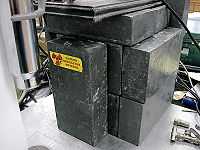
“Radiation protection, sometimes known as radiological protection, is the protection of people and the environment from the harmful effects of ionizing radiation, which includes both particle radiation and high energy electromagnetic radiation. ... [Ionizing radiation] causes microscopic damage to living tissue, resulting in skin burns and radiation sickness at high exposures and statistically elevated risks of cancer, tumors and genetic damage at low exposures. ... There are three factors that control the amount, or dose, of radiation received from a source. Radiation exposure can be managed by a combination of these factors:
- Time: Reducing the time of an exposure reduces the effective dose proportionally. An example of reducing radiation doses by reducing the time of exposures might be improving operator training to reduce the time they take to handle a source.
- Distance: Increasing distance reduces dose due to the inverse square law. Distance can be as simple as handling a source with forceps rather than fingers.
- Shielding: The term 'biological shield' refers to a mass of absorbing material placed around a reactor, or other radioactive source, to reduce the radiation to a level safe for humans.[101]”[22]
Gloveboxes
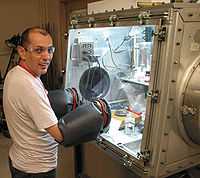
“A glovebox (or glove box) is a sealed container that is designed to allow one to manipulate objects where a separate atmosphere is desired. Built into the sides of the glovebox are gloves arranged in such a way that the user can place their hands into the gloves and perform tasks inside the box without breaking containment. Part or all of the box is usually transparent to allow the user to see what is being manipulated. Two types of gloveboxes exist: one allows a person to work with hazardous substances, such as radioactive materials or infectious disease agents; the other allows manipulation of substances that must be contained within a very high purity inert atmosphere, such as argon or nitrogen. It is also possible to use a glovebox for manipulation of items in a vacuum chamber. ... Gloveboxes used for hazardous materials generally are maintained at a lower pressure than the surrounding atmosphere, so that microscopic leaks result in air intake rather than hazard outflow. Gloveboxes used for hazardous materials generally incorporate HEPA filters into the exhaust, to keep the hazard contained.”[102]
Shield effectiveness
“The effectiveness of a material as a biological shield is related to its cross-section for scattering and absorption, and to a first approximation is proportional to the total mass of material per unit area interposed along the line of sight between the radiation source and the region to be protected. Hence, shielding strength or "thickness" is conventionally measured in units of g/cm2. The radiation that manages to get through falls exponentially with the thickness of the shield. In [X-ray] facilities, the plaster on the rooms with the x-ray generator contains barium sulfate and the operators stay behind a leaded glass screen and wear lead aprons. Almost any material can act as a shield from gamma or x-rays if used in sufficient amounts.
Practical radiation protection tends to be a job of juggling the three factors to identify the most cost effective solution.”[22]
Chemistry
"Many of the radiation effects on materials are produced by collision cascades and covered by radiation chemistry."[51]
"Radiation chemistry is a subdivision of nuclear chemistry which is the study of the chemical effects of radiation on matter; this is very different from radiochemistry as no radioactivity needs to be present in the material which is being chemically changed by the radiation."[103]
"Radiochemistry is the chemistry of radioactive materials, where radioactive isotopes of elements are used to study the properties and chemical reactions of non-radioactive isotopes (often within radiochemistry the absence of radioactivity leads to a substance being described as being inactive as the isotopes are stable). Much of radiochemistry deals with the use of radioactivity to study ordinary chemical reactions. This is very different from radiation chemistry since the radiation levels are kept too low to influence the chemistry."[104]
"Nuclear chemistry is the subfield of chemistry dealing with radioactivity, nuclear processes and nuclear properties. It is the chemistry of radioactive elements such as the actinides, radium and radon together with the chemistry associated with equipment (such as nuclear reactors) which are designed to perform nuclear processes. This includes the corrosion of surfaces and the behavior under conditions of both normal and abnormal operation (such as during an accident). An important area is the behavior of objects and materials after being placed into a nuclear waste storage or disposal site."[105]
Geography

"A geographical area is regarded as a natural environment."[106]
"A species flock may arise when a species penetrates a new geographical area and diversifies to occupy a variety of ecological niches; this process is known as adaptive radiation. The first species flock to be recognized as such was the 13 species of Darwin's finches on the Galápagos Islands described by Charles Darwin."[106]
"Solar radiation increases significantly as the atmosphere gets thinner with increasing altitude thereby absorbing less ultraviolet radiation.[107][108] Snow cover reflecting the radiation can amplify the effects by up to 75% increasing the risks and damage from sunburn and snow blindness.[108]"
"Ionization [of the ionosphere] depends primarily on the Sun and its activity. The amount of ionization in the ionosphere varies greatly with the amount of radiation received from the Sun. Thus there is a diurnal (time of day) effect and a seasonal effect. The local winter hemisphere is tipped away from the Sun, thus there is less received solar radiation. The activity of the Sun is associated with the sunspot cycle, with more radiation occurring with more sunspots. Radiation received also varies with geographical location (polar, auroral zones, mid-latitudes, and equatorial regions)."[109]
Geology
"Granite is a natural source of radiation, like most natural stones. However, some granites have been reported to have higher radioactivity thereby raising some concerns about their safety."[110]
"Some granites contain around 10 to 20 parts per million of uranium. By contrast, more mafic rocks such as tonalite, gabbro or diorite have 1 to 5 PPM uranium, and limestones and sedimentary rocks usually have equally low amounts. Many large granite plutons are the sources for palaeochannel-hosted or roll front uranium ore deposits, where the uranium washes into the sediments from the granite uplands and associated, often highly radioactive, pegmatites. Granite could be considered a potential natural radiological hazard as, for instance, villages located over granite may be susceptible to higher doses of radiation than other communities.[111] Cellars and basements sunk into soils over granite can become a trap for radon gas, which is formed by the decay of uranium.[112] Radon gas poses significant health concerns, and is the number two cause of lung cancer in the US behind smoking.[113]"[110]
"Thorium occurs in all granites as well.[114] Conway granite has been noted for its relatively high thorium concentration of 56 (±6) PPM.[115]"[110]
History

"Meteorites and lunar rocks [may] contain a record of the ancient radiation history of various stars including our own solar system.[116][117][118][119][120][121]"[122]
"The Explorer 3 spacecraft was spin-stabilized and had an on-board tape recorder to provide a complete radiation history for each orbit."[123]
"The Plutonium Files: America's Secret Medical Experiments in the Cold War is a 1999 book by Eileen Welsome. It is a history of U.S. government-engineered radiation experiments on unwitting Americans, based on the Pulitzer Prize–winning series Welsome wrote for The Albuquerque Tribune.[124][125]"[126]
"With their closest relatives, the Maluridae (Australian fairy-wrens), Pardalotidae (pardalotes), and Acanthizidae (thornbills, Australian warblers, scrubwrens, etc.) [the honeyeaters] comprise the superfamily Meliphagoidea and originated early in the evolutionary history of the oscine passerine radiation.[127]"[128]
Mathematics

"The Sakuma–Hattori equation is a mathematical model for predicting the amount of thermal radiation, radiometric flux or radiometric power emitted from a perfect blackbody or received by a thermal radiation detector."[129]
"In its general form it looks like:[130]"[129]
where:
 |
Scalar coefficient |
 |
Second Radiation Constant (0.014387752 m⋅K[131]) |
 |
Temperature dependent effective wavelength in meters |
 |
Temperature in Kelvin. |
"The Stokes parameters are a set of values that describe the polarization state of electromagnetic radiation."[132]
"The relationship of the Stokes parameters to intensity and polarization ellipse parameters is shown in the equations below and the figure at right."[132]
"Here  ,
,  and
and  are the spherical coordinates of the three-dimensional vector of cartesian coordinates
are the spherical coordinates of the three-dimensional vector of cartesian coordinates .
.  is the total intensity of the beam, and
is the total intensity of the beam, and  is the degree of polarization. The factor of two before
is the degree of polarization. The factor of two before  represents the fact that any polarization ellipse is indistinguishable from one rotated by 180°, while the factor of two before
represents the fact that any polarization ellipse is indistinguishable from one rotated by 180°, while the factor of two before  indicates that an ellipse is indistinguishable from one with the semi-axis lengths swapped accompanied by a 90° rotation. The four Stokes parameters are sometimes denoted I, Q, U and V, respectively."[132]
indicates that an ellipse is indistinguishable from one with the semi-axis lengths swapped accompanied by a 90° rotation. The four Stokes parameters are sometimes denoted I, Q, U and V, respectively."[132]
"If given the Stokes parameters one can solve for the spherical coordinates with the following equations:"[132]
Physics
"A particle on the exact design trajectory (or design orbit) of the accelerator only experiences dipole field components, while particles with transverse position deviation  are re-focused to the design orbit. For preliminary calculations, neglecting all fields components higher than quadrupolar, an inhomogenic Hill differential equation
are re-focused to the design orbit. For preliminary calculations, neglecting all fields components higher than quadrupolar, an inhomogenic Hill differential equation
can be used as an approximation,[133] with
- a non-constant focusing force
 , including strong focusing and weak focusing effects
, including strong focusing and weak focusing effects - the relative deviation from the design beam impulse

- the trajectory curvature radius
 , and
, and - the design path length
 ,
,
thus identifying the system as a parametric oscillator. Beam parameters for the accelerator can then be calculated using ray transfer matrix analysis; e.g., a quadrupolar field is analogous to a lens in geometrical optics, having similar properties regarding beam focusing (but obeying Earnshaw's theorem)."[134]
Radioactivity

Def. a spontaneous emission of an α ray, β ray, or γ ray by the disintegration of an atomic nucleus is called radioactivity.[52]
"Although alpha, beta, and gamma radiations were found most commonly, other types of decay were eventually discovered. Shortly after the discovery of the positron in cosmic ray products, it was realized that the same process that operates in classical beta decay can also produce positrons (positron emission). In an analogous process, instead of emitting positrons and neutrinos, some proton-rich nuclides were found to capture their own atomic electrons (electron capture), and emit only a neutrino (and usually also a gamma ray). Each of these types of decay involves the capture or emission of nuclear electrons or positrons, and acts to move a nucleus toward the ratio of neutrons to protons that has the least energy for a given total number of nucleons (neutrons plus protons)."[135]
Roentgens
Def. "the radiation exposure equal to the quantity of ionizing radiation that will produce one esu of charge in one cubic centimetre of dry air at 0 °C and a standard atmosphere”[100] is called a roentgen.
“Using an air ionization energy of about 35 J/C, we have 1 Gy ≈ 111 R.”[100]
Technology
"The RHPPC is a radiation hardened processor based on PowerPC 603e technology licensed from Motorola (now Freescale) and manufactured by Honeywell. The RHPPC is equivalent to the commercial PowerPC 603e processor with the minor exceptions of the phase locked loop (PLL) and the processor version register (PVR). The RHPPC processor is compatible with the PowerPC architecture (Book I-III), the PowerPC 603e programmers interface and is also supported by common PowerPC software tools and embedded operating systems, like VxWorks."[136]
"Demron is a radiation-blocking fabric made by Radiation Shield Technologies. The material is said to have radiation protection similar to lead shielding, while being lightweight and flexible. The composition of Demron is proprietary, but is described as a non-toxic polymer.[137] According to its manufacturer, while Demron shields the wearer from radiation alone, it can be coupled with different protective materials to block chemical and biological threats as well.[138] Demron is roughly three to four times more expensive than a conventional lead apron, but can be treated like a normal fabric for cleaning, storage and disposal.[137] More recent uses for Demron include certified first responder hazmat suits as well as tactical vests. Demron is proven by the United States Department of Energy to significantly reduce high energy alpha and beta radiation, and reduce low energy gamma radiation. When several sheets of Demron are laminated together the result is a much more powerful shield, though Demron cannot completely block all gamma radiation.[139]"[140]
Observation posts

“An observation post, temporary or fixed, is any preselected position from which observations are to be made - this may include very temporary installations ... or even an airborne aircraft.[141][142]"[143][144]
Scintillation detectors
"A scintillation detector or scintillation counter is obtained when a scintillator is coupled to an electronic light sensor such as a photomultiplier tube (PMT) or a photodiode. PMTs absorb the light emitted by the scintillator and reemit it in the form of electrons via the photoelectric effect. The subsequent multiplication of those electrons (sometimes called photo-electrons) results in an electrical pulse which can then be analyzed and yield meaningful information about the particle that originally struck the scintillator."[145]
Research
Hypothesis:
- Radiation has a continuum of speeds.
Control groups

The findings demonstrate a statistically systematic change from the status quo or the control group.
“In the design of experiments, treatments [or special properties or characteristics] are applied to [or observed in] experimental units in the treatment group(s).[146] In comparative experiments, members of the complementary group, the control group, receive either no treatment or a standard treatment.[147]"[148]
Proof of concept
Def. a “short and/or incomplete realization of a certain method or idea to demonstrate its feasibility"[149] is called a proof of concept.
Def. evidence that demonstrates that a concept is possible is called proof of concept.
The proof-of-concept structure consists of
- background,
- procedures,
- findings, and
- interpretation.[150]
See also
- Background radiation
- Becquerel (disintegrations per second)
- Counts per minute
- Curie (unit)
- Ionizing radiation level examples - Example exposure scenarios
- Ionizing radiation units
- Orders of magnitude (radiation)
- Principles of Radiation Astronomy
- Rad (unit)
- Radiation astronomy
- Radiation poisoning
- Relative Biological Effectiveness
- Rem (unit)
- Rutherford (unit)
- Sverdrup (unit) (a non-SI unit of volume transport with the same symbol Sv as Sievert)
- Theoretical radiation astronomy
References
- 1 2 "Radiation, In: Wikipedia". San Francisco, California: Wikimedia Foundation, Inc. May 31, 2012. Retrieved 2012-06-02.
- ↑ "Beta particle, In: Wikipedia". San Francisco, California: Wikimedia Foundation, Inc. August 22, 2012. Retrieved 2012-08-31.
- ↑ "Delta ray, In: Wikipedia". San Francisco, California: Wikimedia Foundation, Inc. February 26, 2013. Retrieved 2013-04-07.
- ↑ "Epsilon radiation, In: Wikipedia". San Francisco, California: Wikimedia Foundation, Inc. March 2, 2013. Retrieved 2013-04-07.
- ↑ "Meteoroid, In: Wikipedia". San Francisco, California: Wikimedia Foundation, Inc. July 1, 2012. Retrieved 2012-07-01.
- ↑ "lithometeor, In: Wiktionary". San Francisco, California: Wikimedia Foundation, Inc. October 21, 2010. Retrieved 2013-02-15.
- ↑ "tephra, In: Wiktionary". San Francisco, California: Wikimedia Foundation, Inc. August 31, 2012. Retrieved 2013-02-17.
- 1 2 3 4 "Micrometeoroid, In: Wikipedia". San Francisco, California: Wikimedia Foundation, Inc. March 12, 2013. Retrieved 2013-04-11.
- 1 2 Micrometeoroids and Orbital Debris (MMOD) - NASA - White Sands Test Facility, Las Cruces, NM
- ↑ "hydrometeor, In: Wiktionary". San Francisco, California: Wikimedia Foundation, Inc. July 7, 2012. Retrieved 2013-02-15.
- ↑ "precipitation, In: Wiktionary". San Francisco, California: Wikimedia Foundation, Inc. February 10, 2013. Retrieved 2013-02-15.
- ↑ "Megacryometeor, In: Wikipedia". San Francisco, California: Wikimedia Foundation, Inc. October 7, 2012. Retrieved 2012-10-13.
- ↑ "cloud, In: Wiktionary". San Francisco, California: Wikimedia Foundation, Inc. February 13, 2013. Retrieved 2013-02-18.
- ↑ "Cloud, In: Wikipedia". San Francisco, California: Wikimedia Foundation, Inc. April 11, 2013. Retrieved 2013-04-13.
- ↑ "jet stream, In: Wiktionary". San Francisco, California: Wikimedia Foundation, Inc. November 10, 2012. Retrieved 2013-02-17.
- ↑ Martin, Christopher; Seibert, M; Neill, JD; Schiminovich, D; Forster, K; Rich, RM; Welsh, BY; Madore, BF et al. (August 17, 2007). "A turbulent wake as a tracer of 30,000 years of Mira's mass loss history". Nature 448 (7155): 780–783. doi:10.1038/nature06003. PMID 17700694.
- ↑ Minkel, JR."Shooting Bullet Star Leaves Vast Ultraviolet Wake", "The Scientific American", August 15, 2007 Accessed August 21, 2007.
- ↑ Christopher Wareing, A. A. Zijlstra, T. J. O'Brien, M. Seibert (November 6, 2007). "It's a wonderful tail: the mass-loss history of Mira". Astrophysical Journal Letters 670 (2): L125–L129. doi:10.1086/524407. http://www.iop.org/EJ/article/1538-4357/670/2/L125/22252.html.
- ↑ W. Clavin (August 15, 2007). "GALEX finds link between big and small stellar blasts". California Institute of Technology. Archived from the original on 2007-08-27. Retrieved 2007-08-16.
- ↑ Christopher Wareing (December 13, 2008). "Wonderful Mira". Philosophical Transactions of the Royal Society A 366 (1884): 4429–40. doi:10.1098/rsta.2008.0167. PMID 18812301.
- ↑ "Mira, In: Wikipedia". San Francisco, California: Wikimedia Foundation, Inc. December 20, 2012. Retrieved 2012-12-21.
- 1 2 3 4 "Radiation protection, In: Wikipedia". San Francisco, California: Wikimedia Foundation, Inc. May 8, 2012. Retrieved 2012-06-02.
- ↑ R Tomaschitz (October 2010). "Superluminal spectral densities of ultra-relativistic electrons in intense electromagnetic wave fields". Applied Physics B Lasers and Optics 101 (1-2): 143-64. doi:10.1007/s00340-010-4182-8. http://www.springerlink.com/index/W575540733147645.pdf. Retrieved 2012-03-21.
- ↑ "Cherenkov radiation, In: Wikipedia". San Francisco, California: Wikimedia Foundation, Inc. April 7, 2013. Retrieved 2013-04-13.
- ↑ "Materials in electronics/The Electron, In: Wikibooks". San Francisco, California: Wikimedia Foundation, Inc. July 13, 2009. Retrieved 2012-06-02.
- ↑ Francis Halzen, Todor Stanev, Gaurang B. Yodh (April 1, 1997). "γ ray astronomy with muons". Physical Review D Particles, Fields, Gravitation, and Cosmology 55 (7): 4475-9. doi:10.1103/PhysRevD.55.4475. http://prd.aps.org/abstract/PRD/v55/i7/p4475_1. Retrieved 2013-01-18.
- ↑ "Muon, In: Wikipedia". San Francisco, California: Wikimedia Foundation, Inc. January 15, 2013. Retrieved 2013-01-18.
- ↑ "Birkeland current, In: Wikipedia". San Francisco, California: Wikimedia Foundation, Inc. October 15, 2012. Retrieved 2012-11-17.
- 1 2 Elizabeth Howell (April 10, 2013). "'Dark Lightning' Sparks Call for More Earth-Gazing Satellites". OurAmazingPlanet. Retrieved 2013-04-12.
- ↑ H. S. Hudson and A. B. Galvin (September 1997). A. Wilson. ed. Correlated Studies at Activity Maximum: the Sun and the Solar Wind, In: Correlated Phenomena at the Sun, in the Heliosphere and in Geospace. Noordwijk, The Netherlands: European Space Agency. pp. 275-82. ISBN 92-9092-660-0. http://adsabs.harvard.edu//abs/1997ESASP.415..275H. Retrieved 2011-11-25.
- ↑ Immanuel Velikovsky. "Uranus". The Immanuel Velikovsky Archive. Retrieved 2013-01-14.
- ↑ "continuum, In: Wiktionary". San Francisco, California: Wikimedia Foundation, Inc. March 13, 2013. Retrieved 2013-04-10.
- ↑ "Continuum (measurement), In: Wikipedia". San Francisco, California: Wikimedia Foundation, Inc. March 19, 2013. Retrieved 2013-04-10.
- ↑ "emission, In: Wiktionary". San Francisco, California: Wikimedia Foundation, Inc. March 12, 2013. Retrieved 2013-04-11.
- ↑ "Emission spectrum, In: Wikipedia". San Francisco, California: Wikimedia Foundation, Inc. April 2, 2013. Retrieved 2013-04-11.
- ↑ "absorb, In: Wiktionary". San Francisco, California: Wikimedia Foundation, Inc. March 31, 2013. Retrieved 2013-04-11.
- ↑ "absorption, In: Wiktionary". San Francisco, California: Wikimedia Foundation, Inc. March 12, 2013. Retrieved 2013-04-11.
- ↑ "Absorption (electromagnetic radiation), In: Wikipedia". San Francisco, California: Wikimedia Foundation, Inc. April 8, 2013. Retrieved 2013-04-11.
- ↑ "Attenuation coefficient, In: Wikipedia". San Francisco, California: Wikimedia Foundation, Inc. April 9, 2013. Retrieved 2013-04-11.
- ↑ "Range (particle radiation), In: Wikipedia". San Francisco, California: Wikimedia Foundation, Inc. March 2, 2013. Retrieved 2013-04-11.
- ↑ "Stopping power (particle radiation), In: Wikipedia". San Francisco, California: Wikimedia Foundation, Inc. April 11, 2013. Retrieved 2013-04-11.
- 1 2 3 "Spectral bands, In: Wikipedia". San Francisco, California: Wikimedia Foundation, Inc. April 7, 2013. Retrieved 2013-04-12.
- 1 2 3 4 5 6 7 "Background radiation, In: Wikipedia". San Francisco, California: Wikimedia Foundation, Inc. April 6, 2013. Retrieved 2013-04-12.
- 1 2 United Nations Scientific Committee on the Effects of Atomic Radiation (2008 (published 2010)). Sources and effects of ionizing radiation. New York: United Nations. p. 4. ISBN 978-92-1-142274-0. http://www.unscear.org/unscear/en/publications/2008_1.html. Retrieved 9 November 2012.
- ↑ United Nations Scientific Committee on the Effects of Atomic Radiation (2006 (published 2008)). "Annex E: Sources-to-effects assessment for radon in homes and workplaces". Effects of Ionizing Radiation. II. New York: United Nations. ISBN 978-92-1-142263-4. http://www.unscear.org/docs/reports/2006/09-81160_Report_Annex_E_2006_Web.pdf. Retrieved 2 December 2012.
- ↑ "Radioactive human body — Harvard University Natural Science Lecture Demonstrations". April 2011.
- ↑ http://www.ead.anl.gov/pub/doc/carbon14.pdf
- ↑ Isaac Asimov (1976) [1957]. "The Explosions Within Us". Only A Trillion (Revised and updated ed.). New York: ACE books. pp. 37–9. ISBN 1-157-09468-6.
- 1 2 "Radiation sensitivity, In: Wikipedia". San Francisco, California: Wikimedia Foundation, Inc. January 2, 2012. Retrieved 2013-04-09.
- ↑ "radiation damage, In: Wiktionary". San Francisco, California: Wikimedia Foundation, Inc. August 31, 2011. Retrieved 2013-04-09.
- 1 2 3 4 5 6 7 "Radiation damage, In: Wikipedia". San Francisco, California: Wikimedia Foundation, Inc. March 16, 2013. Retrieved 2013-04-09.
- 1 2 Philip B. Gove, ed (1963). Webster's Seventh New Collegiate Dictionary. Springfield, Massachusetts: G. & C. Merriam Company. pp. 1221.
- ↑ Theodore E. Madey, Robert E. Johnson, Thom M. Orlando (March 2002). "Far-out surface science: radiation-induced surface processes in the solar system". Surface Science 500 (1-3): 838-58. doi:10.1016/S0039-6028(01)01556-4. http://www.sciencedirect.com/science/article/pii/S0039602801015564. Retrieved 2012-02-09.
- ↑ Edison Pettit (July 1943). "The Properties of Solar Prominences as Related to Type". Astrophysical Journal 98 (7): 6-19. doi:10.1086/144539.
- 1 2 3 Vincent Tatischeff, J.-P. Thibaud, I. Ribas (January 2008). "Nucleosynthesis in stellar flares". eprint arXiv:0801.1777. http://arxiv.org/abs/0801.1777. Retrieved 2012-11-09.
- ↑ Edwin V. Bell, II (December 11, 2012). "Mercury". Greenbelt, Maryland: NASA Goddard Space Flight Center. Retrieved 2013-04-13.
- ↑ P. D. Spudis (2001). "The Geological History of Mercury". Workshop on Mercury: Space Environment, Surface, and Interior, Chicago: 100.
- ↑ "Mercury (planet), In: Wikipedia". San Francisco, California: Wikimedia Foundation, Inc. April 10, 2013. Retrieved 2013-04-13.
- ↑ Dolginov, Nature of the Magnetic Field in the Neighborhood of Venus, COsmic Research, 1969
- ↑ Kivelson G. M., Russell, C. T. (1995). Introduction to Space Physics. Cambridge University Press. ISBN 0-521-45714-9.
- ↑ Upadhyay, H. O.; Singh, R. N. (April 1995). "Cosmic ray Ionization of Lower Venus Atmosphere". Advances in Space Research 15 (4): 99–108. doi:10.1016/0273-1177(94)00070-H.
- 1 2 "Venus, In: Wikipedia". San Francisco, California: Wikimedia Foundation, Inc. September 27, 2012. Retrieved 2012-10-04.
- ↑ W. B., Rossow; A. D., del Genio; T., Eichler (1990). "Cloud-tracked winds from Pioneer Venus OCPP images" (PDF). Journal of the Atmospheric Sciences 47 (17): 2053–2084. doi:10.1175/1520-0469(1990)047<2053:CTWFVO>2.0.CO;2. ISSN 1520-0469. http://journals.ametsoc.org/doi/pdf/10.1175/1520-0469%281990%29047%3C2053%3ACTWFVO%3E2.0.CO%3B2.
- ↑ Normile, Dennis (7 May 2010). "Mission to probe Venus's curious winds and test solar sail for propulsion". Science 328 (5979): 677. doi:10.1126/science.328.5979.677-a. PMID 20448159.
- ↑ Carolyn Jones Otten (2004). "'Heavy metal' snow on Venus is lead sulfide". Washington University in St Louis. Retrieved 2007-08-21.
- ↑ "Snow, In: Wikipedia". San Francisco, California: Wikimedia Foundation, Inc. February 12, 2013. Retrieved 2013-02-16.
- ↑ J. P. Barringer's acceptance speech. Meteoritics, volume 28, page 9 (1993). Retrieved on the SAO/NASA Astrophysics Data System
- ↑ Grieve, R.A.F. (1990) Impact Cratering on the Earth, Scientific American 262(4), 66–73.
- 1 2 "Meteor Crater, In: Wikipedia". San Francisco, California: Wikimedia Foundation, Inc. October 1, 2012. Retrieved 2012-10-09.
- 1 2 "Canyon Diablo (meteorite), In: Wikipedia". San Francisco, California: Wikimedia Foundation, Inc. August 3, 2012. Retrieved 2012-10-09.
- ↑ McSween Jr., Harry Y. (1976). "A new type of chondritic meteorite found in lunar soil". Earth and Planetary Science Letters 31 (2): 193–9. doi:10.1016/0012-821X(76)90211-9.
- ↑ Rubin, Alan E. (1997). "The Hadley Rille enstatite chondrite and its agglutinate-like rim: Impact melting during accretion to the Moon". Meteoritics & Planetary Science 32 (1): 135–41. doi:10.1111/j.1945-5100.1997.tb01248.x.
- 1 2 "Lunar meteorite, In: Wikipedia". San Francisco, California: Wikimedia Foundation, Inc. August 30, 2012. Retrieved 2012-09-28.
- ↑ Treiman, A.H.; et al. (October 2000). "The SNC meteorites are from Mars". Planetary and Space Science 48 (12–14): 1213–30. doi:10.1016/S0032-0633(00)00105-7.
- ↑ "Martian meteorite, In: Wikipedia". San Francisco, California: Wikimedia Foundation, Inc. February 10, 2013. Retrieved 2013-02-15.
- ↑ "Mackinac Island meteorite, In: Wikipedia". San Francisco, California: Wikimedia Foundation, Inc. March 23, 2013. Retrieved 2013-04-10.
- 1 2 Patrick Michel, Fabbio Migliorini, Alessandro Morbidelli, Vincenzo Zappalà (June 2000). "The Population of Mars-Crossers: Classification and Dynamical Evolution". Icarus 145 (2): 332-47. doi:10.1006/icar.2000.6358. http://www.sciencedirect.com/science/article/pii/S0019103500963589. Retrieved 2011-10-06.
- ↑ Kelley, M. S.; et al. (2003). "Quantified mineralogical evidence for a common origin of 1929 Kollaa with 4 Vesta and the HED meteorites". Icarus 165 (1): 215. doi:10.1016/S0019-1035(03)00149-0.
- ↑ "Vesta". NASA/JPL. 12 July 2011. Archived from the original on 29 June 2011. Retrieved 30 July 2011.
- ↑ "4 Vesta, In: Wikipedia". San Francisco, California: Wikimedia Foundation, Inc. April 12, 2013. Retrieved 2013-04-13.
- ↑ Miriam Kramer (April 10, 2013). "Saturn's Dazzling Rings Make It 'Rain'". Space.com. Retrieved 2013-04-12.
- ↑ James O'Donoghue (April 10, 2013). "Saturn's Dazzling Rings Make It 'Rain'". Space.com. Retrieved 2013-04-12.
- ↑ James O'Donoghue (April 10, 2013). "Blame it on the Rain (from Saturn's Rings)". Pasadena, California USA: NASA/JPL. Retrieved 2013-04-12.
- ↑ Kevin Baines (April 10, 2013). "Blame it on the Rain (from Saturn's Rings)". Pasadena, California USA: NASA/JPL. Retrieved 2013-04-12.
- ↑ Tom Stallard (April 10, 2013). "Blame it on the Rain (from Saturn's Rings)". Pasadena, California USA: NASA/JPL. Retrieved 2013-04-12.
- 1 2 3 4 Jia-Rui C. Cook, Joe Mason, and Michael Buckley (March 17, 2011). "Cassini Sees Seasonal Rains Transform Titan's Surface". Pasadena, California USA: NASA/JPL. Retrieved 2013-04-12.
- ↑ Elizabeth Turtle (March 17, 2011). "Cassini Sees Seasonal Rains Transform Titan's Surface". Pasadena, California USA: NASA/JPL. Retrieved 2013-04-12.
- ↑ Tony Del Genio (March 17, 2011). "Cassini Sees Seasonal Rains Transform Titan's Surface". Pasadena, California USA: NASA/JPL. Retrieved 2013-04-12.
- 1 2 3 4 Sue Lavoie (March 17, 2011). "PIA12810: Equatorial Titan Clouds". Pasadena, California USA: NASA/JPL. Retrieved 2013-04-12.
- ↑ "RS Ophiuchi, In: Wikipedia". San Francisco, California: Wikimedia Foundation, Inc. March 24, 2012. Retrieved 2012-11-08.
- ↑ G. D. Wesley-Hunt (2005). "The morphological diversification of carnivores in North America". Paleobiology 31: 35–55. doi:10.1666.2F0094-8373.282005.29031.3C0035:TMDOCI.3E2.0.CO.3B2.
- ↑ Schluter, D. (2000). The Ecology of Adaptive Radiation. Oxford University Press.
- 1 2 "Evolutionary radiation, In: Wikipedia". San Francisco, California: Wikimedia Foundation, Inc. February 27, 2013. Retrieved 2013-04-07.
- ↑ This topic is covered in a very accessible manner in Chapter 11 Richard Fortey (1997). Life: An Unauthorised Biography.
- ↑ "Hawaiian lobelioids, In: Wikipedia". San Francisco, California: Wikimedia Foundation, Inc. March 6, 2013. Retrieved 2013-04-13.
- 1 2 "The 2007 Recommendations". International Commission on Radiological Protection. Retrieved 2011-04-15.
- 1 2 "Sievert, In: Wikipedia". San Francisco, California: Wikimedia Foundation, Inc. June 1, 2012. Retrieved 2012-06-02.
- ↑ A D Wrixon. "New ICRP recommendations". Journal on Radiological Protection. Retrieved 2011-04-15.
- ↑ "The International System of Units (SI)". Bureau International des Poids et Mesures (BIPM). Retrieved 2010-01-31.
- 1 2 3 "Gray (unit), In: Wikipedia". San Francisco, California: Wikimedia Foundation, Inc. February 20, 2012. Retrieved 2013-04-13.
- ↑ "Biological shield". United States Nuclear Regulatory Commission. Retrieved 13 August 2010.
- ↑ "Glovebox, In: Wikipedia". San Francisco, California: Wikimedia Foundation, Inc. May 29, 2012. Retrieved 2012-06-02.
- ↑ "Radiation chemistry, In: Wikipedia". San Francisco, California: Wikimedia Foundation, Inc. February 27, 2013. Retrieved 2013-04-12.
- ↑ "Radiochemistry, In: Wikipedia". San Francisco, California: Wikimedia Foundation, Inc. February 23, 2013. Retrieved 2013-04-12.
- ↑ "Nuclear chemistry, In: Wikipedia". San Francisco, California: Wikimedia Foundation, Inc. March 30, 2013. Retrieved 2013-04-12.
- 1 2 "Species flock, In: Wikipedia". San Francisco, California: Wikimedia Foundation, Inc. March 15, 2013. Retrieved 2013-04-13.
- ↑ Cymerman, A; Rock, PB. Medical Problems in High Mountain Environments. A Handbook for Medical Officers. USARIEM-TN94-2. US Army Research Inst. of Environmental Medicine Thermal and Mountain Medicine Division Technical Report. http://archive.rubicon-foundation.org/7976. Retrieved 2009-03-05.
- 1 2 Hamilton, AJ. Biomedical Aspects of Military Operations at High Altitude. USARIEM-M-30/88. US Army Research Inst. of Environmental Medicine Thermal and Mountain Medicine Division Technical Report. http://archive.rubicon-foundation.org/7975. Retrieved 2009-03-05.
- ↑ "Ionosphere, In: Wikipedia". San Francisco, California: Wikimedia Foundation, Inc. April 12, 2013. Retrieved 2013-04-13.
- 1 2 3 "Granite, In: Wikipedia". San Francisco, California: Wikimedia Foundation, Inc. April 12, 2013. Retrieved 2013-04-13.
- ↑ "Radiation and Life". World Nuclear Association. July 2002. Retrieved 2010-02-04.
- ↑ "Decay series of Uranium". Retrieved 2008-10-19.
- ↑ "Radon and Cancer: Questions and Answers". National Cancer Institute. Retrieved 2008-10-19.
- ↑ M. King Hubbert (March 8th, 1956. Republished on March 8th, 2006, by the Energy Bulletin). "Nuclear Energy and the Fossil Fuels". American Petroleum Institute Conference. Retrieved May 21st, 2012.
- ↑ "THE CONWAY GRANITE OF NEW HAMPSHIRE AS A MAJOR LOW-GRADE THORIUM RESOURCE". 1962.
- ↑ "New York Times:Big Science; Is It Worth the Price?; Small-Scale Science Feels the Pinch From Big Projects". September 4, 1990. pp. page 3 of 5.
- ↑ "New York Times:PLANES SOAR INTO STRATOSPHERE TO SNARE BITS OF THE COSMIC PAST". May 11, 1982. pp. page 2 of 3.
- ↑ "National Academies Press:National Academy of Sciences;Biographical Memoirs;Robert M. Walker;By P. Buford Price and Ernst Zinner".
- ↑ "Washington University, St. Louis;Robert M Walker;1929 - 2004".
- ↑ "Washington University, St. Louis;Robert M Walker;Meteoritics and Planetary Science".
- ↑ "New York Times:Union College:Robert M, walker, director of the laboratory for space physics".
- ↑ "Robert M. Walker (physicist), In: Wikipedia". San Francisco, California: Wikimedia Foundation, Inc. July 30, 2012. Retrieved 2013-04-13.
- ↑ "Explorer 3, In: Wikipedia". San Francisco, California: Wikimedia Foundation, Inc. March 23, 2013. Retrieved 2013-04-13.
- ↑ "Book review, in The New England Journal of Medicine" 341. December 16, 1999. pp. 1941–1942.
- ↑ "Book Review, in the Bulletin of the History of Medicine" 76 (3). Fall 2002. pp. 637–8.
- ↑ "The Plutonium Files, In: Wikipedia". San Francisco, California: Wikimedia Foundation, Inc. March 17, 2013. Retrieved 2013-04-13.
- ↑ Barker et al. 2004
- ↑ "Honeyeater, In: Wikipedia". San Francisco, California: Wikimedia Foundation, Inc. March 12, 2013. Retrieved 2013-04-13.
- 1 2 "Sakuma–Hattori equation, In: Wikipedia". San Francisco, California: Wikimedia Foundation, Inc. November 7, 2012. Retrieved 2013-04-13.
- ↑ J. Fischer, P. Saunders, M. Sadli, M. Battuello, C. W. Park, Y. Zundong, H. Yoon, W. Li, E. van der Ham, F. Sakuma, Y. Yamada, M. Ballico, G. Machin, N. Fox, J. Hollandt, M. Matveyev, P. Bloembergen and S. Ugur, "Uncertainty budgets for calibration of radiation thermometers below the silver point" (pdf), CCT-WG5 on Radiation Thermometry, BIPM, Sèvres, France (2008).
- ↑ "2006 CODATA recommended values". National Institute of Standards and Technology (NIST). Dec 2003. Retrieved Apr 27, 2010.
- 1 2 3 4 "Stokes parameters, In: Wikipedia". San Francisco, California: Wikimedia Foundation, Inc. April 9, 2013. Retrieved 2013-04-13.
- ↑ { {cite book | author = Klaus Wille | title = Particle Accelerator Physics: An Introduction | publisher = Oxford University Press | year = 2001 | isbn = 978-0-19-850549-5 }} (slightly different notation)
- ↑ "Accelerator physics, In: Wikipedia". San Francisco, California: Wikimedia Foundation, Inc. February 26, 2013. Retrieved 2013-04-13.
- ↑ "Radioactive decay, In: Wikipedia". San Francisco, California: Wikimedia Foundation, Inc. April 13, 2013. Retrieved 2013-04-13.
- ↑ "RHPPC, In: Wikipedia". San Francisco, California: Wikimedia Foundation, Inc. October 12, 2011. Retrieved 2013-04-13.
- 1 2 "Radiation-proof fabric developed". Associated Press. 2002-11-14. Retrieved 2006-10-24.
- ↑ "Radiation Shield Technologies (RST) - Online Store". Retrieved 2006-10-24.
- ↑ "Radiation Shield Technologies (RST) - Research Results" (pdf). Retrieved 2008-01-02.
- ↑ "Demron, In: Wikipedia". San Francisco, California: Wikimedia Foundation, Inc. April 18, 2011. Retrieved 2013-04-13.
- ↑ DoD News Briefing, February 15, 1996 1:30 pm EST (from a DoD news briefing. Accessed 2008-06-21.)
- ↑ {{ cite journal |author=Francoise Micheau |contribution=The Scientific Institutions in the Medieval Near East |pages=992–3|, in (Rashed & Morelon 1996, pp. 985–1007)
- ↑ "Observation post, In: Wikipedia". San Francisco, California: Wikimedia Foundation, Inc. August 30, 2012. Retrieved 2012-10-09.
- ↑ "Observatory, In: Wikipedia". San Francisco, California: Wikimedia Foundation, Inc. May 11, 2012. Retrieved 2012-05-15.
- ↑ "Scintillator, In: Wikipedia". San Francisco, California: Wikimedia Foundation, Inc. June 7, 2012. Retrieved 2012-06-19.
- ↑ Klaus Hinkelmann, Oscar Kempthorne (2008). Design and Analysis of Experiments, Volume I: Introduction to Experimental Design (2nd ed.). Wiley. ISBN 978-0-471-72756-9. http://books.google.com/?id=T3wWj2kVYZgC&printsec=frontcover.
- ↑ R. A. Bailey (2008). Design of comparative experiments. Cambridge University Press. ISBN 978-0-521-68357-9. http://www.cambridge.org/uk/catalogue/catalogue.asp?isbn=9780521683579.
- ↑ "Treatment and control groups, In: Wikipedia". San Francisco, California: Wikimedia Foundation, Inc. May 18, 2012. Retrieved 2012-05-31.
- ↑ "proof of concept, In: Wiktionary". San Francisco, California: Wikimedia Foundation, Inc. November 10, 2012. Retrieved 2013-01-13.
- ↑ Ginger Lehrman and Ian B Hogue, Sarah Palmer, Cheryl Jennings, Celsa A Spina, Ann Wiegand, Alan L Landay, Robert W Coombs, Douglas D Richman, John W Mellors, John M Coffin, Ronald J Bosch, David M Margolis (August 13, 2005). "Depletion of latent HIV-1 infection in vivo: a proof-of-concept study". Lancet 366 (9485): 549-55. doi:10.1016/S0140-6736(05)67098-5. http://www.ncbi.nlm.nih.gov/pmc/articles/PMC1894952/. Retrieved 2012-05-09.
Further reading
- Introduction to Quantities and Units for Ionising Radiation National Physical Laboratory
- Radiation Protection Japanese Nuclear Emergency: EPA's Radiation Air Monitoring
External links
- African Journals Online
- Bing Advanced search
- GenomeNet KEGG database
- Google Books
- Google scholar Advanced Scholar Search
- Home - Gene - NCBI
- International Astronomical Union
- JSTOR
- Lycos search
- NASA's National Space Science Data Center
- NCBI All Databases Search
- Office of Scientific & Technical Information
- Questia - The Online Library of Books and Journals
- SAGE journals online
- The SAO/NASA Astrophysics Data System
- Scirus for scientific information only advanced search
- SIMBAD Astronomical Database
- Spacecraft Query at NASA.
- SpringerLink
- Taylor & Francis Online
- WikiDoc The Living Textbook of Medicine
- Wiley Online Library Advanced Search
- Yahoo Advanced Web Search
| |||||||||||||||||||||||||||||||||||
| |||||||||||||||||||||||||||||||||||
| ||||||||||||||||||||||||||||||||||||||||||||
| ||||||||||||||||||||||||||||||||||||||
| |||||||||||||||||||||||||||||
| |||||||||||||||||||||||||||||||||||||||||
![]() This is a research project at http://en.wikiversity.org
This is a research project at http://en.wikiversity.org
| |
Development status: this resource is experimental in nature. |
| |
Resource type: this resource is an article. |
| |
Educational level: this is a research resource. |
| |
Resource type: this resource contains a lecture or lecture notes. |
| |
Subject classification: this is an astrophysics resource. |
| |
Subject classification: this is a physics resource . |





